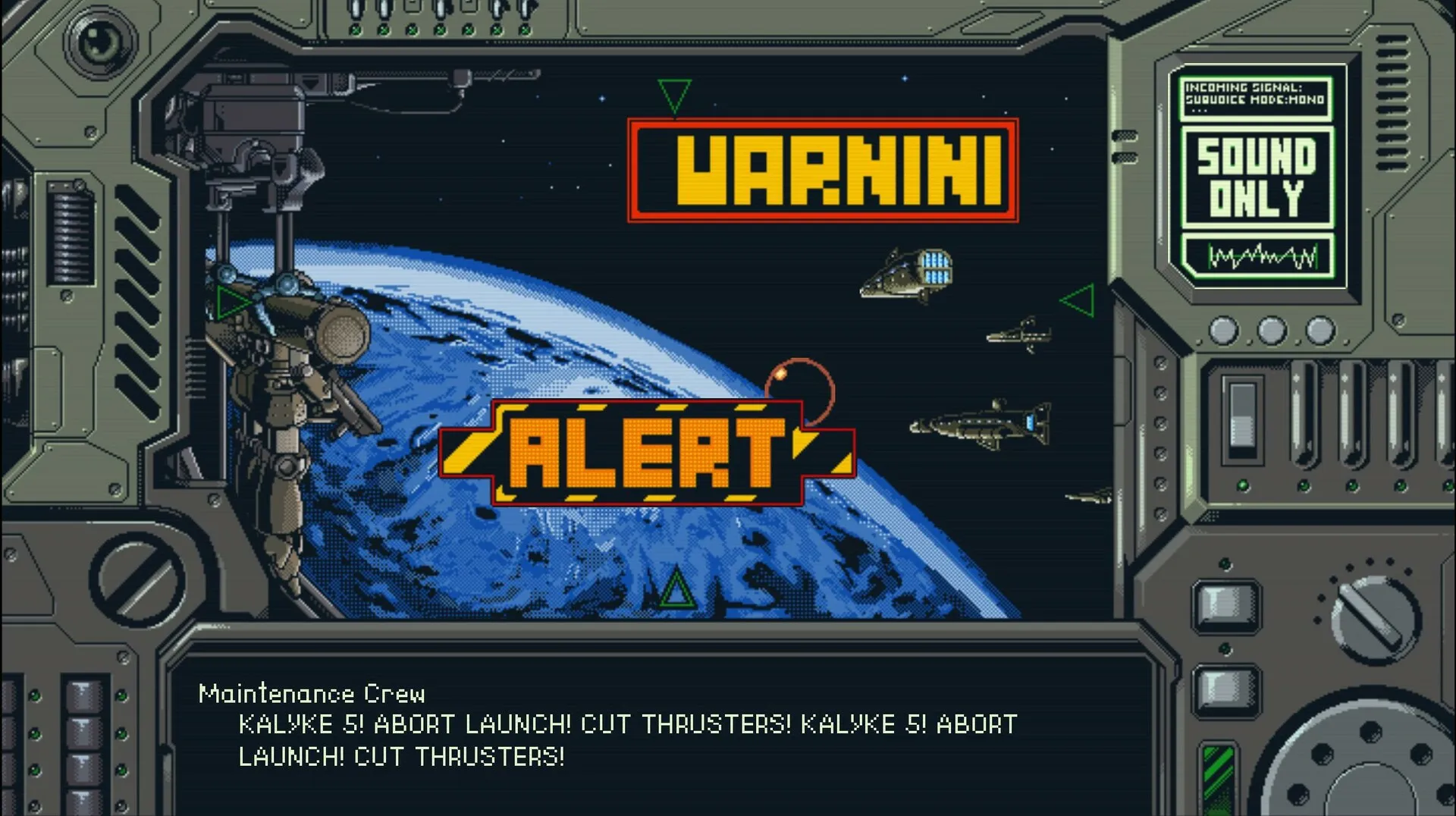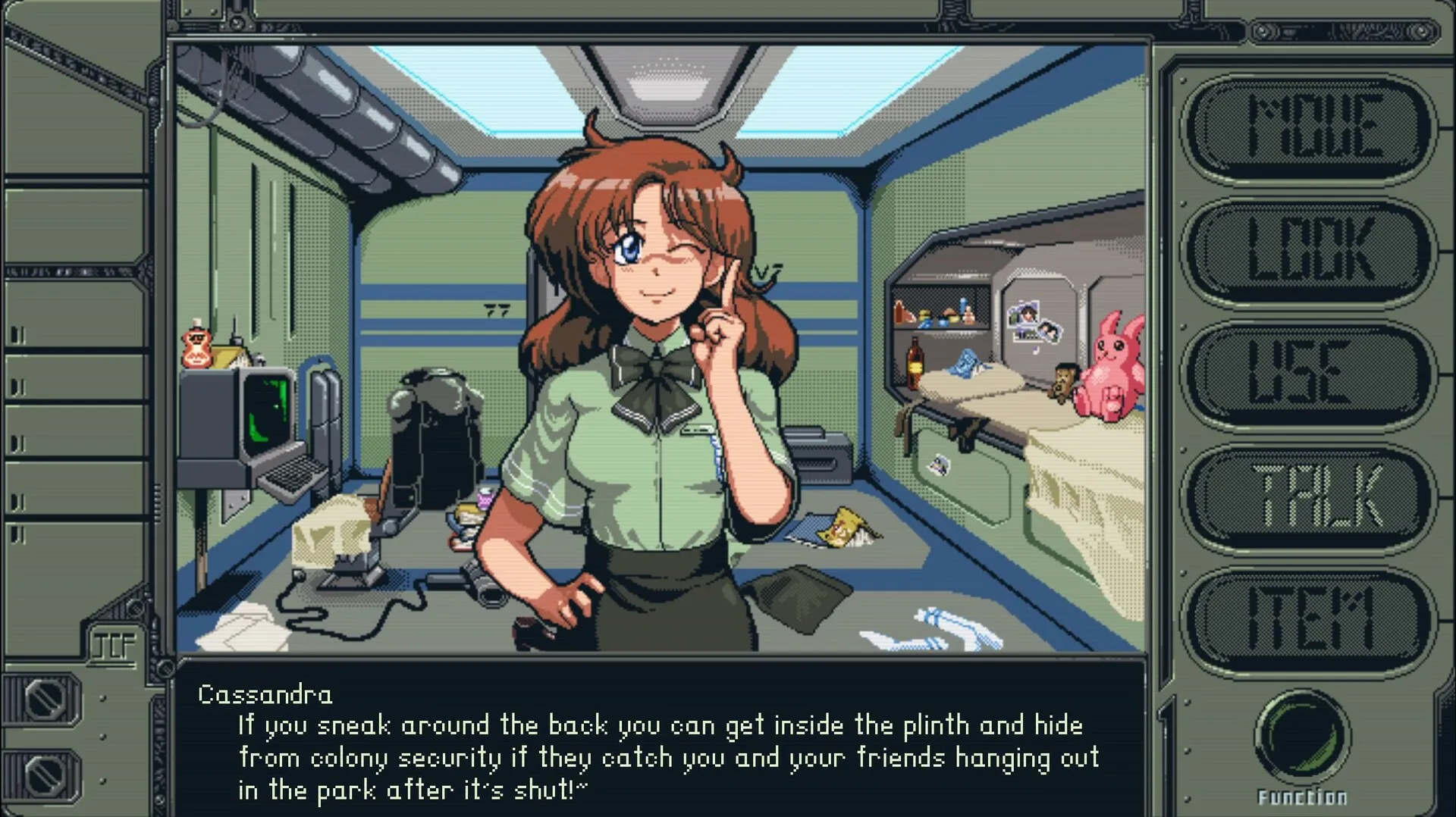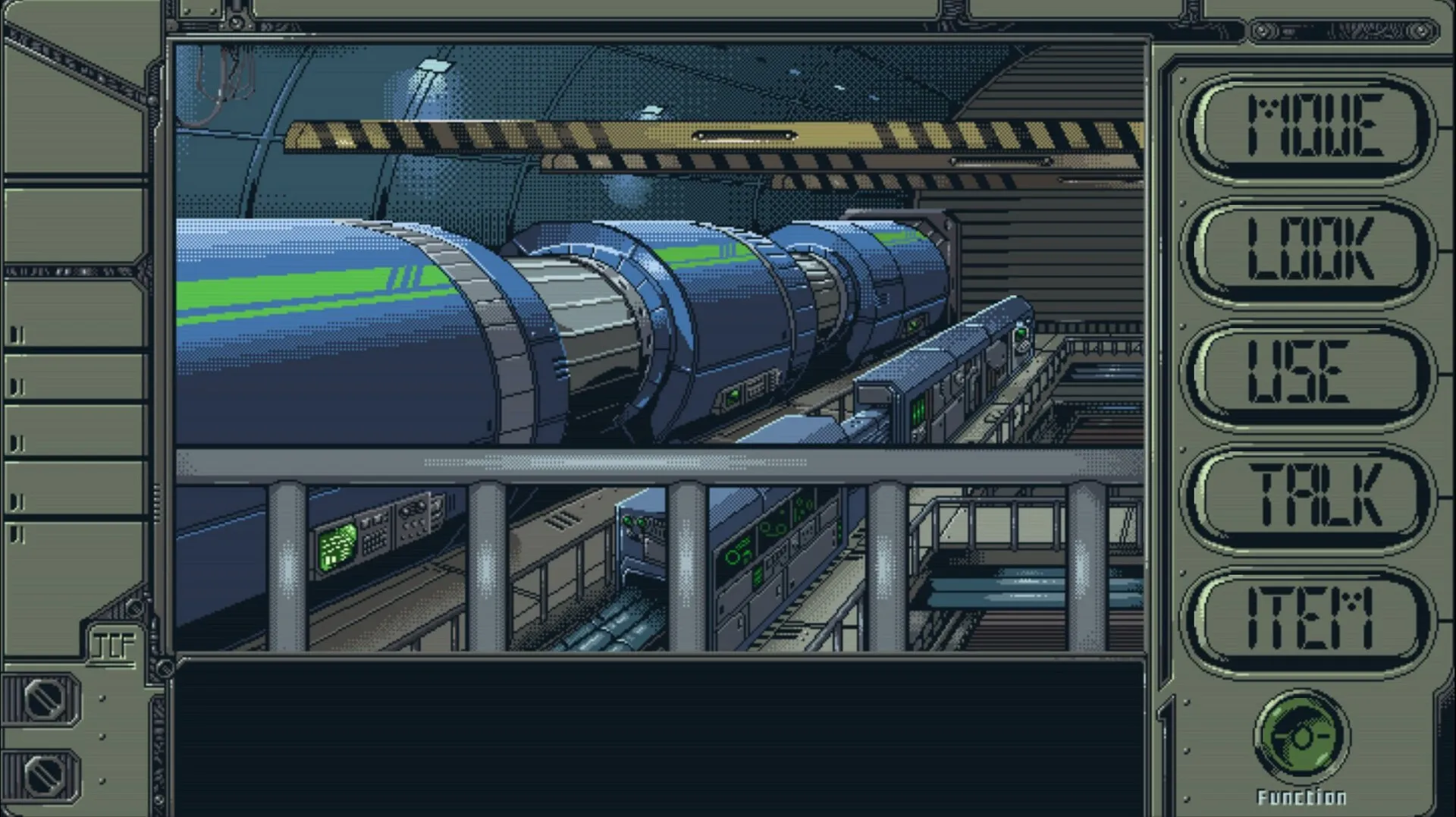Stories from Sol: The Gun-Dog takes place after the Solar War, a conflict that pitted Earth-based humans against communities in space colonies and distant planets. In this environment, you step into the role of a security officer aboard the modest Gun-Dog spacecraft. The protagonist carries memories of a failed military encounter, a reminder of past hardships that continue to influence their present.
Tasked with investigating unusual transmissions from a similar vessel, the character is thrust into a situation where personal history and duty converge. The confined setting of the spaceship is rendered with care, each room and corridor hinting at mysteries that extend beyond the immediate mission.
The game draws clear inspiration from classic PC-98 visual novels and hard sci-fi anime from the 1980s. Its visual presentation employs detailed sprite art and occasional animated sequences that recall the look of well-known titles from that period.
Modern narrative techniques are interwoven with these traditional visual cues, producing an experience that fits snugly within its genre. Comparisons can be made to other retro-inspired narratives that balance familiar themes with a refreshed approach, offering a setting that remains engaging while staying true to its roots.
Narrative and Storyline: Exploring the Mystery and Replay Elements
Stories from Sol: The Gun-Dog centers on a security officer aboard the Gun-Dog spacecraft, assigned to investigate unusual signals from another vessel. The plot unfolds as a mystery wrapped in episodic segments, with each chapter presenting distinct dramatic beats that keep the tension active.
Early sequences take the player back through flashbacks that reveal the protagonist’s earlier struggles during a critical military failure. These sequences offer insight into the character’s personal losses and set up the ongoing narrative conflict. The structured progression of scenes delivers moments of high suspense alongside quieter, reflective interludes, a design that invites comparisons to classic visual narratives where personal history strongly informs current conflicts.
The game employs a traditional text-based command system featuring options like Move, Look, and Use, reminiscent of established visual novels in the genre. This approach to gameplay invites careful attention to detail, as each choice can subtly shift the unfolding mystery. The integration of meta elements, such as alternate scenarios that appear on subsequent playthroughs, provides an incentive for revisiting the narrative.
Notably, the cliffhanger ending leaves a portion of the story open for future exploration, allowing the game to extend its narrative potential while still delivering a complete experience in a single session. Comparisons to similar titles in the field highlight a consistent commitment to narrative precision and player engagement, with the system encouraging multiple runs to uncover all hidden facets of the story.
Characterization and Crew Dynamics: Personal Histories and Relationships
The lead character assumes the role of a security officer on the Gun-Dog following a conflict that left lasting marks. Their history includes a mission that ended disastrously, a setback that continues to influence their actions aboard the ship.
This experience informs their cautious approach to everyday duties and interactions with fellow crew members. The narrative presents this character evolution through reflective moments and interactions that remind players of similar portrayals in established sci-fi visual narratives, where past errors serve as a catalyst for personal growth and accountability.
Within the tightly knit team, individual roles are distinctly outlined. Lieutenant Commander Cassandra Quinn, for example, is depicted as both competent in managing operations and challenged by personal conflicts with the protagonist—a dynamic influenced by their close relationship.
Chief Engineer Mackenzie Cathays, known for her clear and direct manner, anchors the group with practical problem-solving skills. Other crew members, such as the reserved gunner, the anxious cadet, and the pilots with contrasting temperaments, round out the ensemble. Each character contributes specific traits that shape group interactions and generate realistic tensions.
The narrative carefully outlines these relationships, using moments of personal interaction to deepen the overall story. Romantic subplots and moments of professional camaraderie create layers that remind one of character-driven dramas in the genre, where every member plays a part in the ongoing mission aboard the Gun-Dog.
Visual Presentation and Art Style: Classic Inspirations in a Modern Setting
The game employs sprite-based artwork that channels the look of classic PC-98 titles. The character sprites and backgrounds are rendered with a keen attention to pixel-level detail, recalling visuals from earlier visual novels.
Animated sequences punctuate key moments, offering flashes of visual excitement reminiscent of established works in the genre. A variety of visual styles appear throughout, each reflecting influences from distinct eras of retro anime. This art direction supports the narrative tone by maintaining a consistent visual approach that complements the unfolding story without distracting from the plot.
The design of in-game environments receives careful treatment as well. The interior of the Gun-Dog spaceship is arranged with meticulous attention to layout, with distinct areas that create a palpable sense of space. Each compartment holds subtle design cues that contribute to the mood, encouraging players to explore and absorb the setting fully.
The user interface is clean and functional, featuring clearly labeled menus and interactive elements that integrate seamlessly with the visual theme. The interface design aids exploration while reinforcing the retro aesthetic through its minimalist yet effective presentation.
When compared to other titles in the genre, the visual presentation here stands apart due to its commitment to a refined retro style. The balance between detailed artwork and functional design elements reflects a deliberate approach to merging classic influences with modern narrative techniques. This results in a visual experience that is both faithful to its inspirations and tailored to support the gameplay and storytelling throughout the adventure.
Audio and Soundtrack: Setting the Mood
The soundtrack features a chiptune-inspired score that contributes strongly to the overall mood of the game. The music is designed to mark scene transitions, echoing moments of tension, relief, and dramatic revelation.
In several sequences, the score shifts to a lighter tone, counterbalancing narrative intensity—a method seen in other visual novels with retro roots. Each track is arranged to align with the unfolding plot, ensuring that key narrative moments are underscored by carefully chosen themes that complement the visual presentation without distracting from it.
The sound design employs ambient effects to heighten suspense during pivotal moments. Background noises and subtle environmental cues work in tandem with the musical score to build a layered auditory experience.
These sound cues clarify shifts between exploration and narrative beats aboard the Gun-Dog spaceship, helping to establish the atmosphere in a manner similar to other well-executed entries in the genre. The interplay between audio and visuals enriches the gameplay, as the deliberate integration of sound deepens the immersive quality of each scene and supports the emotional cadence of the unfolding story.
Gameplay Mechanics and Interface: Interactive Storytelling and Exploration
The game adopts a text-based format where players control the narrative through specific commands such as Move, Look, and Use. Each command serves as a tool for revealing details about the environment or advancing the plot.
The design emphasizes a careful selection of actions that prompt further narrative developments, echoing methods found in well-known visual novel adventures. Players must choose when to inspect a room or interact with an object, with each decision affecting how the story unfolds. This approach requires attention to detail and offers an experience reminiscent of other narrative-driven titles that rely on choice and consequence to build tension and engagement.
The environment aboard the Gun-Dog is structured with a clear emphasis on exploration. The inclusion of a mini-map and task indicators provides guidance while maintaining a sense of discovery. These elements help players identify areas of interest within the ship and assist in managing objectives. Interactive puzzles scattered throughout the journey add complexity to the gameplay.
For instance, certain sequences demand the player’s active engagement to uncover hidden details or progress through challenging segments, a design choice that enriches the unfolding narrative. Comparisons can be drawn to other visual novels that incorporate interactive puzzles to deepen player immersion. Each puzzle is woven into the narrative, ensuring that exploration feels both purposeful and rewarding without straying from the core storytelling experience.
Themes, Replayability, and Future Outlook: The Narrative’s Lasting Impact
The narrative centers on a universe recovering from conflict, with the legacy of a devastating war serving as the backdrop for personal struggle and renewal. The game examines the consequences of military failure through a protagonist burdened by past setbacks.
Flashback sequences reveal moments of loss and personal regret, providing insight into the character’s internal conflict. These narrative elements are tightly interwoven with a mystery that arises from unexplained signals and events, prompting players to consider the hidden costs of war.
The text-driven gameplay reinforces these themes by requiring players to make choices that impact the unfolding story. Command-based interactions, such as Move, Look, and Use, serve to highlight the tension between past errors and the possibility of recovery. This approach aligns with techniques seen in other narrative-focused visual novels, where every decision uncovers another facet of a complex character arc and overarching mystery.
Replay value is built into the structure through alternate scenarios that present subtle shifts in narrative outcomes. Multiple playthroughs reveal different aspects of the story, encouraging players to revisit the game and uncover additional layers of meaning.
These branching narrative choices not only add depth to the experience but also hint at potential expansions or future installments. By embedding hints of ongoing developments within its design, the game opens the door to further exploration of its established themes and promises continued character evolution in upcoming releases.
The Review
Stories from Sol: The Gun-Dog
Stories from Sol: The Gun-Dog delivers a charming retro presentation paired with thoughtful character interactions. Its narrative combines mystery with personal history, and the text-based interface guides players through an engaging yet sometimes underdeveloped plot. The design remains consistent, with inventive flashbacks that enhance the overall experience for visual novel fans.
PROS
- Strong retro art style and detailed sprite-based visuals
- Engaging chiptune soundtrack that enhances the mood
CONS
- Limited branching routes may restrict replay value
- Narrative occasionally feels underdeveloped





















































